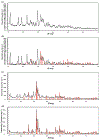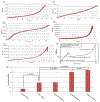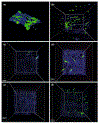A self-organising biomimetic collagen/nano-hydroxyapatite-glycosaminoglycan scaffold for spinal fusion
- PMID: 29977095
- PMCID: PMC6029624
- DOI: 10.1007/s10853-017-1229-9
A self-organising biomimetic collagen/nano-hydroxyapatite-glycosaminoglycan scaffold for spinal fusion
Abstract
The use of spinal fusion surgery as a treatment for degenerative spinal conditions and chronic back pain is increasing. However, this technique requires use of a bone grafting material to fuse the vertebrae, traditionally autologous bone, which consists of an optimal combination of osteogenic cell precursors, extracellular matrix proteins and mineral components. To date, this remains the 'gold standard' material but its supply is limited and is associated with a number of clinical and ethical difficulties; consequently, various combinations of cells with biological scaffold materials have been tested but have failed to achieve fusion rates even comparable to autologous bone. We successfully fabricated a novel collagen-based scaffold using self-organising atelocollagen combined with nano-hydroxyapatite and chondroitin sulphate, cross-linked by microbial transglutaminase. The scaffold was characterised using a range of imaging, chemical composition and thermal analysis techniques. It was found to exhibit appropriate stiffness and suitable pore size for the adhesion, growth and differentiation of MSCs. The low toxicity makes it suitable for clinical application, and its slow degradation profile would enable the scaffold to promote bone growth over an extended period. This material therefore shows promise for clinical use in spinal fusion and other procedures requiring the use of bone grafts.
Conflict of interest statement
Compliance with ethical standards Conflicts of interest No conflict of interests to declare.
Figures












References
-
- Rajaee SS et al. (2012) Spinal fusion in the United States: analysis of trends from 1998–2008. Spine 37(1):67–76 - PubMed
-
- Zhang P et al. (2008) Clinical study of lumbar fusion by hybrid construct of stem cells technique and biodegradable material. Zhonghua wai ke za zhi Chin J Surg 46(7):493–496 - PubMed
-
- Neen D et al. (2006) Healos and bone marrow aspirate used for lumbar spine fusion: a case controlled study comparing healos with autograft. Spine 31(18):E636–E640 - PubMed
-
- Kuwahara K et al. (2011) Enzymatic crosslinking and degradation of gelatin as a switch for bone morphogenetic protein-2 activity. Tissue Eng Part A 17(23–24):2955–2964 - PubMed
Grants and funding
LinkOut - more resources
Full Text Sources
Other Literature Sources
